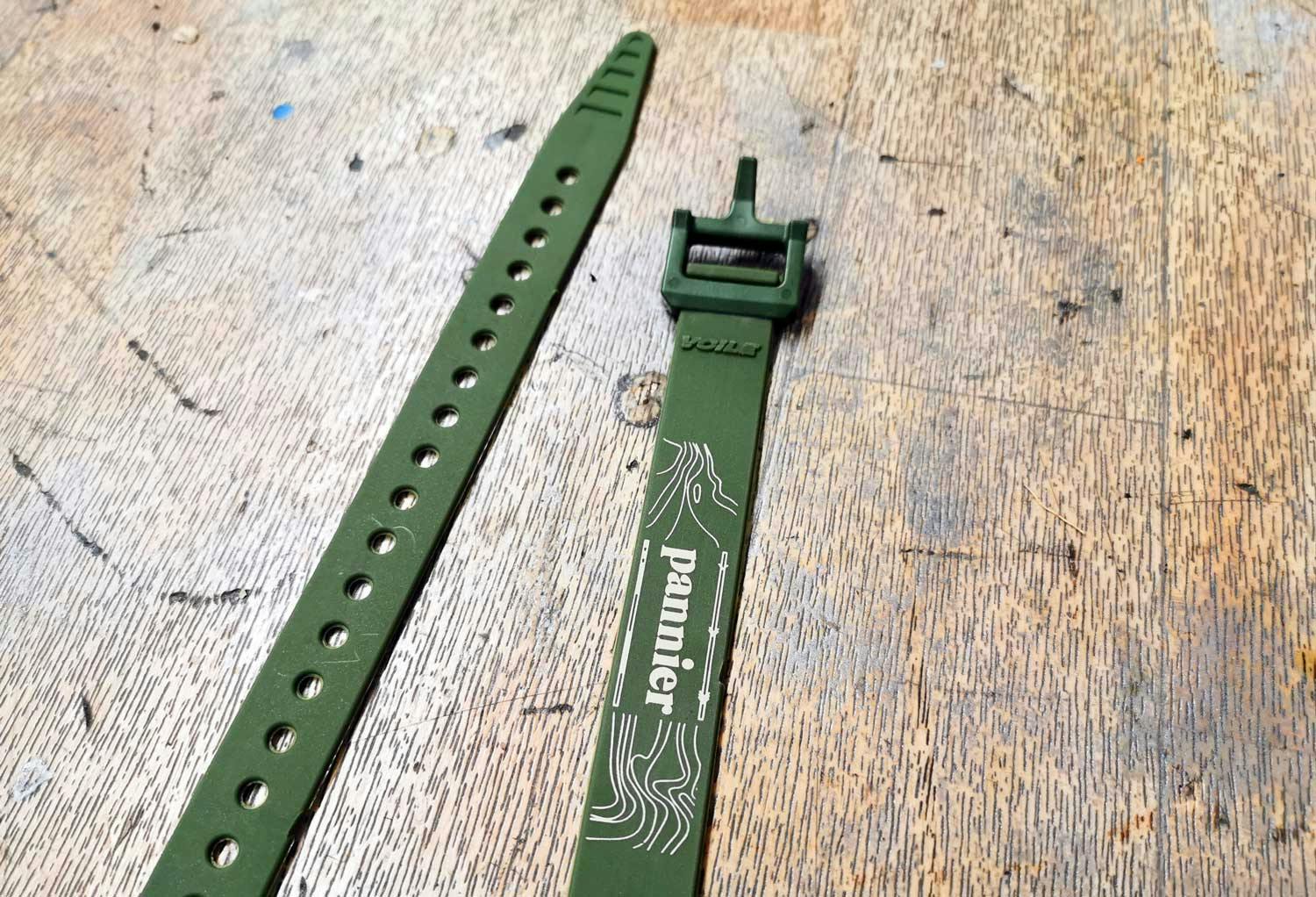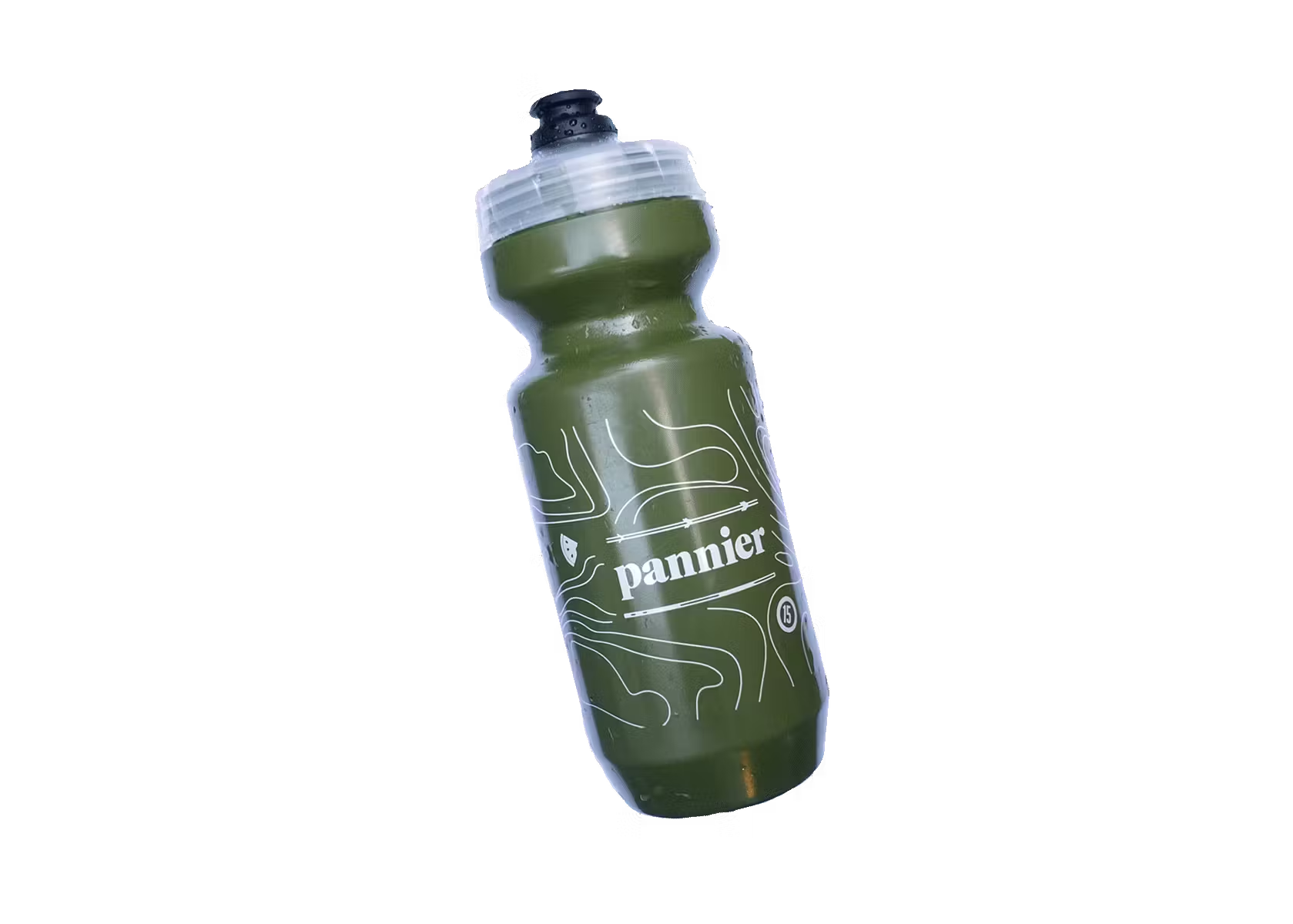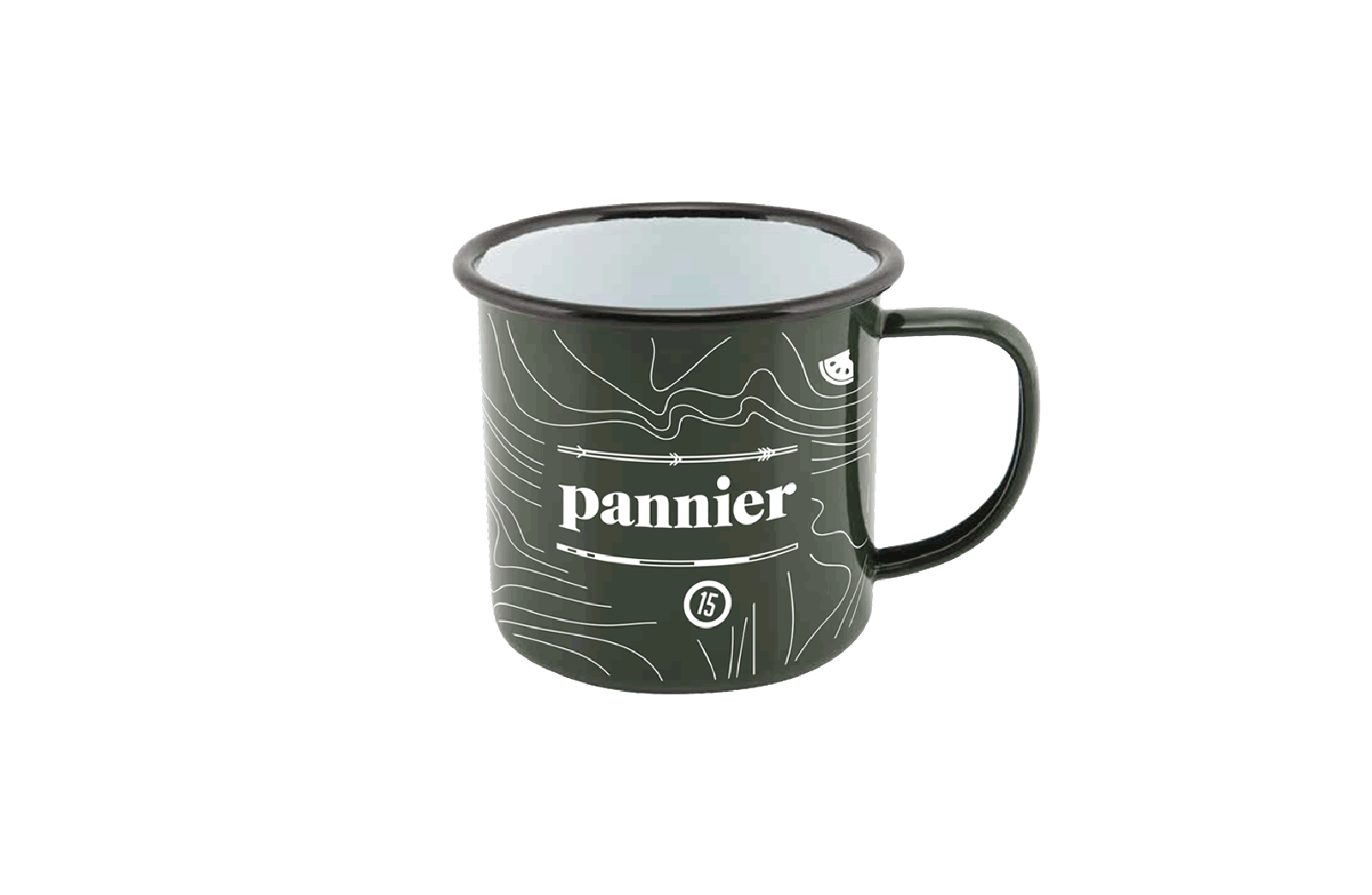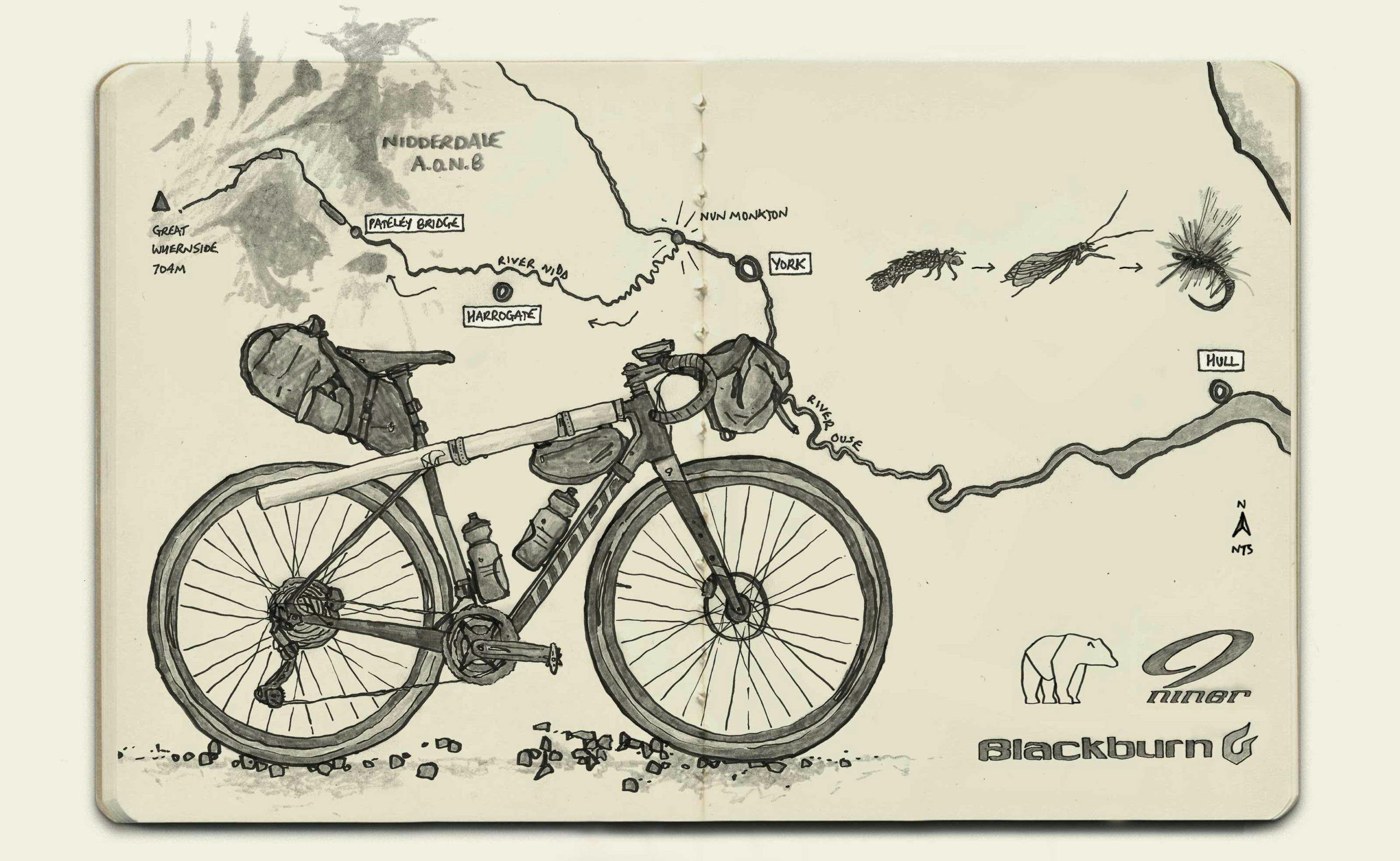
“Many m̶e̶n̶ people go fishing all of their lives, without knowing that it is not fish they are after” Henry David Thoreau
The Nidd’s cold dark waters flowed ever-closer to the line of my rolled-up bikepacking shorts with every precarious step over the rocky riverbed, as the four of us waded upstream. ‘Twas early morning, just a five-kilometre ride south of our overnight stopover in the Nidderdale village of Lofthouse where our fly-fishing friend and guide, Oscar, is based. We were in the river proper – amongst the water wonderland ecosystem – the sporadic sunlight dappling the dense summer tree canopies that shrouded our setting. Just moments ago, Oscar had lifted a peaty brown rock from said riverbed to highlight the entomology that fly-fishing is largely based around: clinging caddis casings – the first stage of a fly’s life – one of the many foodie items that a ‘fly’ on the end of a rod and line is meant to imitate. Soon after, I was casting; casting into the quick-moving water and pockets of river where Nidd trout would most likely be hanging out, facing upstream, fighting the flow in search of food and oxygenated water.
A popular pursuit already, bikefishing and the idea of combining cycling/bikepacking and fishing has been a leisure mainstay in places like North America and Japan (the originators of a simpler style of fishing known as ‘Tenkara’) for a long time now. However, this trip in Yorkshire was an opportunity for us to figure it all trout, alongside expert fly-fisherfolk, and to work on curating an ace Pannier UK Bikefishing experience in, what we were soon to discover, such a wonderful riding and fly fishing playground…

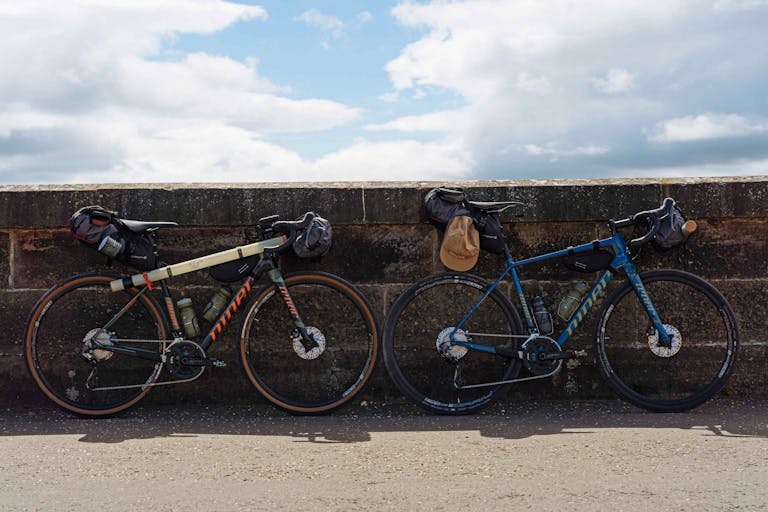

Rewind twenty-four hours. David, Duncan and I were loading bikes with overnight and fishing kit (rods, reels, flies and lines) at the end of the River Nidd, but the start of our bikefishing journey – the confluence with the River Ouse, in Nun Monkton. The sandy beach on the inside bend of the river junction and its lush green surrounds was like a Constable painting. Well, sort of. A cross between the romance of a Constable countryside scene, and the social commentary of a Martin Parr photograph: parents cloudbathing under distinctly overcast skies; kids running, swimming, and shouting around. It was the summer holiday, in post-lockdown England, after all.
From here, the Ouse then flows onwards through York and into the North Sea at the Humber Estuary – the Nidd’s upland waters having travelled nearly 200 kilometres. We, however, would be heading the opposite way, inland and upstream, following the river’s farmed floodplains and meandering meadows, riding Nidderdale’s Greenways, viaducts, gorges and lanes, past Harrogate to Pateley Bridge – gateway to The Secret Dale – ending at the springing source on Nidderdale Area of Natural Beauty’s border with the Yorkshire Dales National Park.
After a quick ceremonial dip in The Nidd myself, bikepacking bibs for swimwear, we set off. Destination: Lofthouse, 60 kilometres away. Riding north through Nidderdale, the roads would get narrower, the hills higher, the moors wilder, and the river smaller…














Reaching Lofthouse earlier than planned, we decided to make the most of the longer summertime days – picking Oscar up, and continuing up the tarmac road to its dead-end at Scar House Reservoir for our first fly-fishing session.
Scar House is the middle of three upland reservoirs fed by the River Nidd, at the head of Nidderdale. Riding up towards the towered dam horizon, we were surrounded by a growing landscape that forged the Nidd’s stunning ridged-watershed theatre. The majority of these moorlands were high pastures for sheep, patterned with an array of dry-stone walls and stone-sheep-barns. We shared routes with farmers on their quad bikes, border collie dogs working hard up in the hills to round up the scores of sheep. Herding whistles echoed through the valley as we rode the stunning gravel track that ran along the northern shore to our fishing spot, not far from the foot of next dam up: Angram.
This reservoir is a remote Wild Brown Trout fishery and offers good wild fishing for brown trout from the bank – stillwater fly-fishing in one of the most scenic locations you could ask for. The last of the sun lit up the now distant dam as we unpacked rods, put them together, attached reels and flies, and headed out along the rock groyne that took us an extra 10M away from the shoreline to begin casting. Stillwater fishing is a totally different game to river fishing – a subject that is extensively covered elsewhere if you want to read all about it(!) – and it’s easy to see why. Varying habitats and ecosystems mean the fish behave and live differently – they hang out in different places and feed on different things which means experience / a bit of luck is needed to suss patterns out. One thing is for sure, there is no better place to learn about rods and casting than a wide, open, empty reservoir shoreline. As a beginner, there is every chance you will cast a hook onto your own clothes at some point…
The dwindling light signalled the end to our fly-fishing introduction session. We brewed a quick coffee and munched the rest of our picnic pies from Pateley Bridge, before packing up, heading back over the now dusky dark dam, and pretty much freewheeling back down to Lofthouse for the night…







So, what additional kit do you need for a bikefishing trip, on top of a standard bikepacking kit list? Everything on the left column of the kit grid photo below, basically:
– fishing rod
– fishing reel/line
– flies
– river footwear/sandals
– waders (optional)
Regarding rods, there are a couple of formats depending on the type of fishing you want to do. Traditional fly-fishing (with a rod and reel/line) or Tenkara (with a typically shorter rod and a fixed line). You might have heard the term Tenkara – especially in the bikepacking world – because of their association with packable rods that pack down to something small you can even just strap to the top of a hip pack. Tenkara is actually originally a Japanese term for “fishing from heaven”and is the style for the popular mountain-stream fly-fishing there without a reel or long fishing line – for close-cast fishing in smaller bodies of water and mountain streams. There is also a US brand called Tenkara, which make tenkara fishing equipment and paraphernalia.
So, why would you take a traditional 9-10ft three-piece rod, rather than a modern-day packable rod without reel? For us, it was a case of learning to cast, for lake and reservoir stillwater fishing (which you need a longer, further line for), and starting out with the more traditional fly-fishing approach. It is always best to revert to simpler, more minimal methods once you’ve learned the ropes, right? On this trip, the rods you see us using are the more traditional 9-10ft rods, that break down into 3/4 pieces, and mean a carry tube with a length of 2-3ft…
In order to carry these on the bike, David went for the front handlebar (width-ways) loading option for his fishing rod; I went for the top tube (length-ways) mounting option. Those are two of the three/four options for carrying fishing kit on the bike, really, unless you have one of the collapsible Tenkara style rods, that fit onto a hip pack or within a bike bag. The other, as below, would be strapped to the fork legs.

1 – Top Tube x Voile Strap
2 – Fork x Voile Strap
3 – Handlebar x Bag / Harness
1 – length-ways, with some angled adjustment – you’ll be able to make it work so your knees sail past for an uninterrupted pedal stroke. The beauty of voile straps. Again.
2 – a great spot, providing your tube isn’t too long to affect handling – hand positions and handlebar movements. Our rods / tubes were too cumbersome for fork placement.
3 – width-ways, which worked well on the gravel moorland tracks; less so for escaping tight city streets.
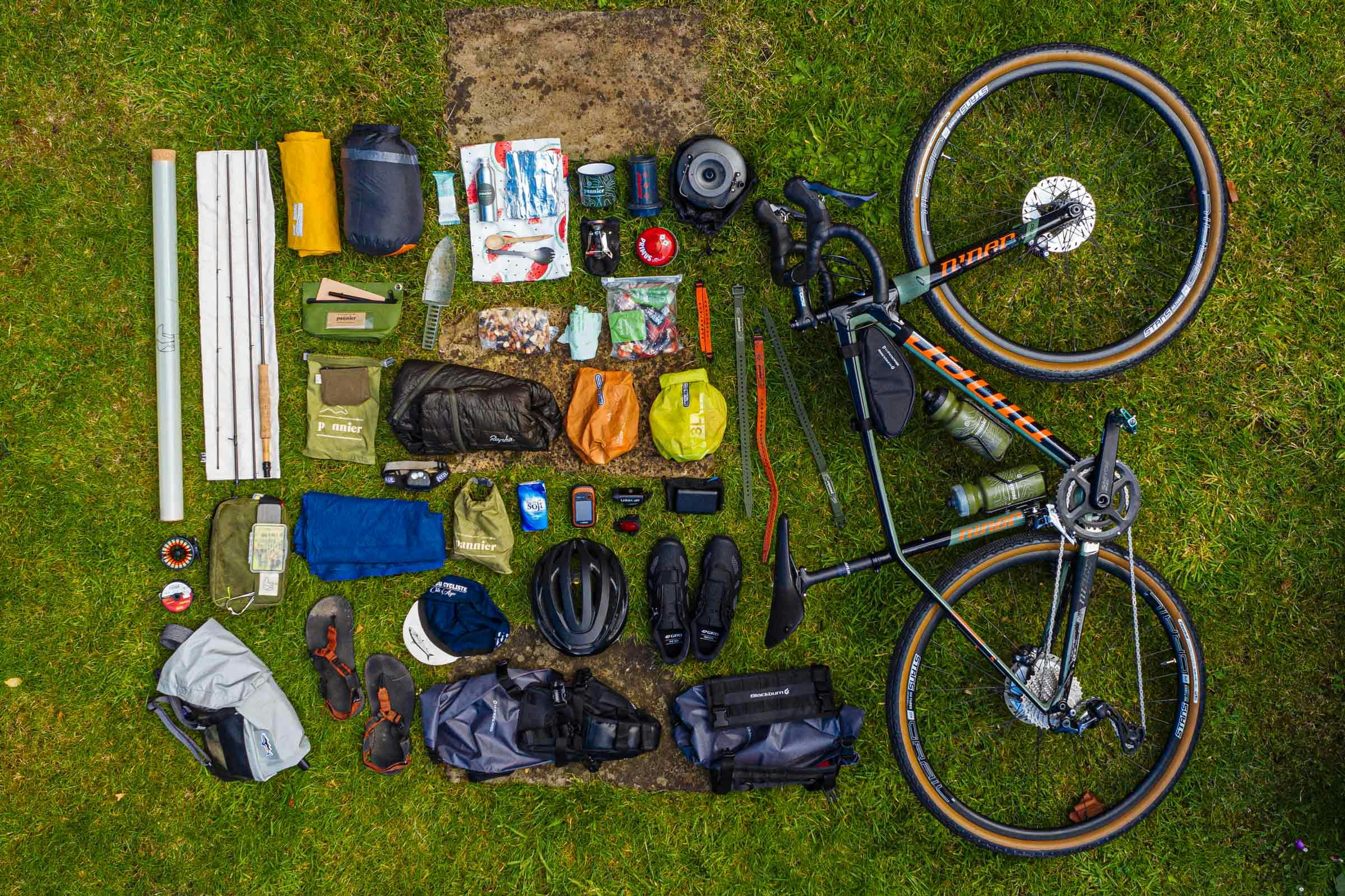


David and I rode Niner RLT RDO gravel bikes on this trip (in Baja Blue and Olive Green, respectively) loaded with Blackburn Design’s rock-solid Outpost bikepacking bag range. The last time I’d seen a Niner RLT – ‘Roads Less Travelled’ – in the flesh was Jordan’s zippy steel cyclocross bike on our Beulah trip in 2016. Niner’s drop bar gravel bikes are now fit for 700x50c / 650×2″ and come in three tiers: the RLT (Aluminium); RLT Steel; and RLT RDO (‘Race-Day-Optimised’ Carbon). The last four-five years development of all-road/adventure/gravel bikes, since that first RLT I’d ridden alongside to the very northwest point of the UK mainland, are epitomised in these new bikes we were riding:
– “room to roam” as Niner call it – increased frame clearance for bigger tyres, and the option to run both 700c and smaller 650b wheels, which means up to 2.0” width
– tubeless setup
– mounty mcmountface framesets – plenty (26 to be precise) of threaded mounts to carry a lot of kit – top tube, downtube, inner triangle, and forks.
– internal cable routing
– geometries with longer chainstays (back-end) and slacker headtube angles (front-end) to offer a tad more comfort on your off-road adventures, whilst still maintaining some aggression for speedier road and gravel rides.
These bikes really are ideal for this type of lighter-weight bikepacking trip. Fastpacking, almost, whilst still offering the ability to carry cargo, like fishing rods. Speedy and agile on the road and lanes, comfy and capable on the chunky gravel, and lightweight and nimble for when the roads and gravel ended … and the real off-road (hike-a-bike) adventure begun.



entomology [noun]
– the branch of zoology concerned with the study of insects
Lofthouse is a peaceful village to wake up. Over brekkie and a brew, I asked Oscar if he’d go through some of the entomology and tactics of fly-fishing. I knew he tied his own flies, both to use personally and commercially, and watching him in action made it clear he had tied thousands of flies over the years; one of the most impressive / therapeutic things I’ve seen for a long while. The basic idea is that a fly-fishing fly (the bit at the end of the line that sits on/in the water and incorporates the hook) is supposed to imitate an insect – typically a ‘caddis’ or ‘olive’ – two of maybe 5-6 types of bugs on the river. Oscar’s flies are purposefully more general, with the idea that they mimic a few – “like nature, nothing is perfect, so why should the flies be?” he swears.
Obviously, differing insects and bugs exist in various locations, water bodies and ecosystems, so the design and choice of a fly is, again, all part of a fly-fishers knowledge set. Oscar really helped by unveiling what he meant by a ‘caddis’ in the river that morning – casings that cling to the bed and rocks, which house the early stages of a fly – bright yellow worm-like pupa/ulva. Seeing this, was the perfect way of helping to understand the basics for me – a couple of short sessions with Oscar taught me a lot. Even simple things like fish stay still, facing upstream to feed, likely in a sheltered but fast flowing spot because that water carries a lot of good stuff and churns up ‘food’ from the bed. That then informs where trout are likely to be in a river, to then direct a cast.
Fishing in the River Nidd that morning was special. Special for both learning new things, new skills, and for realising how everything is connected; how important biodiversity is in natural habitats. Healthy water means healthy ecosystems – thriving insect, fish, bird, vegetation and fauna populations – which in turn means healthy water. And, of course, thriving tourism given The Secret Dale’s ‘Area of Natural Beauty’ status. This is where the fine balance lies…

















After a late brunch in Ramsgill we headed back to Scar House Reservoir, and beyond, to seek the source of the Nidd at Nidd Head Spring. Today, we’d ride a different roughstuff route via the quaint hilltop village of Middlesmoor, and the gravel switchback tracks instead. To our left, a series of alluring gravel tracks led up into, what looked like, dead-end moody valleys. We’d no doubt be taking something similar a bit further on, beyond the reservoirs.
gill [noun]
– a narrow mountain stream
beck [noun]
– a stream
sike [noun]
– a small stream or rill, typically one that flows through marshy ground and is often dry in summer.
dike [noun]
– a watercourse
Shaws Gill, Trows Beck, Wench Gill, Crook Dike, Long Hill Sike. All names of the watercourses that ran down from the moorlands into the Nidd or reservoirs, that our route crossed as we traversed the wild grassy uplands below Little Whernside. Our route to the source was officially a bridleway, but there wasn’t much sign of even hikers’ footprints. Faint tracks soon disappeared into thick high grasslands after the last obvious farmstead; a carry was the only option. When was the last time people had taken this route? Today we shared the big Nidd landscapes with the sight and sounds of Oyster Catchers and tiny Skylarks, somehow battling the super strong winds. Our modest journey to the source of the Nidd would take a lot longer than first thought. Classic.
We plodded on. A lot was rideable; a lot was not. Bog is a challenge. But, who were we to complain? It was our idea. After meeting up with the Little Whernside – Great Whernside ridgeline footpath, we continued around the valley maintaining 600m elevation, eventually coming to what must have been the, or one of, the Nidd’s marshy, boggy sources. We decided to call it a day there, happy that we’d tracked the 90 kilometres of the River Nidd. It was wild up there. Stunning, but somewhat silly with a gravel bike in tow…




Over our forty-eight hour bikepacking trip, we’d ridden, swam, drank, waded, hiked, and fished the Nidd’s waters. And, yes, that one little trout in the net is the only fish we caught in two fly-fishing sessions. But, that’s not the point. The point is the pursuit; the joy, serenity and escape of being immersed in our water ecosystems and upland watershed landscapes. Riding, wading, watching, observing, casting, striking, repeating. As Thoreau said: “Many m̶e̶n̶ people go fishing all of their lives, without knowing that it is not fish they are after” and after my first proper bikefishing experience, I couldn’t agree more. Except I already knew it wasn’t the fish I was after. You know what I mean.
When you have the chance, strap a fishing rod to your bike and get yourself bikefishing – it’s the reel deal. Over and out…
[For details of our next Yorkshire Bikefishing weekend – based in Nidderdale – check out the Pannier Tour Pages]
In order to fish freshwater in the UK, you’ll need an Environmental Agency Fishing License which you can seek and sort online.
Before fishing, make sure to check the rules on fishing in your location. The waters will be owned by someone – whether privately, by a fishing club, or large organisation – and will be subject to certain rules/restrictions.
Photography
Duncan Philpott
Words & Illustrations
Stef Amato
Fly-Fishing Tutor & Tyer
Oscar Boatfield (Bear U.K.)
Tourers
Dave Sear
Duncan Philpott
Stef Amato
WESSEX WANDERINGS: BIKEPACKING KING ALFRED’S WAY
Five Ride Out Of Covid-19 Lockdown, onto King Alfred's Way - a new 350km bikepacking route around the ancient kingdom of Wessex; across vast downlands that somehow echo the comfort of a countryside in which man has always been at home...
by STEF AMATO & DAVE SEAR
WESSEX WANDERINGS: BIKEPACKING KING ALFRED’S WAY
Five Ride Out Of Covid-19 Lockdown, onto King Alfred's Way - a new 350km bikepacking route around the ancient kingdom of Wessex; across vast downlands that somehow echo the comfort of a countryside in which man has always been at home...
